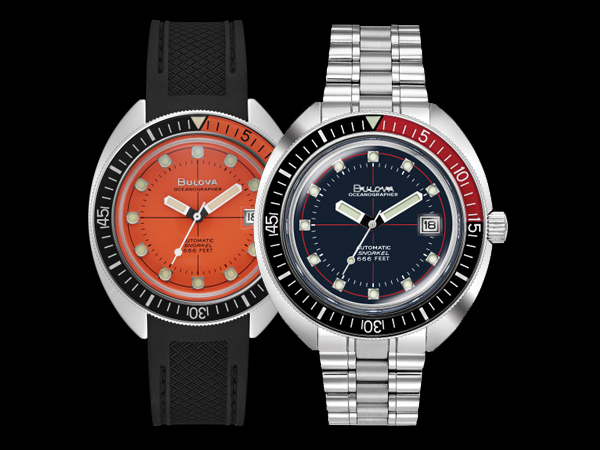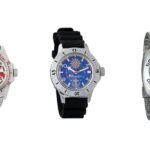It goes without saying that the Bulova Oceanographer is an icon in the dive watch category. This vintage watch offers a rich history that transcends more than just the brand’s heritage. From the vibrant 1970s, its design and features remain relevant to this day. This rugged tool watch saw an evolution that’s one hell of a showstopper. It is a timepiece that exceed expectations when it comes to functionality and design. At a time when watches can only go as far as 660ft (200m), Bulova takes this watch 6ft deeper. Let’s take a closer look at the history and evolution of the Bulova Oceanographer — one of the iconic 666 Devil Diver watches.
When dive watches are at the peak of the hype, many manufacturers jumped on the trend. However, not everyone got it right. Even with the earlier launch of watches such as the Rolex Submariner or the Omega Seamaster, no watch carries the same merits as the Bulova Oceanographer, specifically the Snorkel. This watch, despite its name, goes deeper than just for snorkelling purposes. Anyone who has used or experienced wearing this watch could attest to its excellent functionality.
But before we get to the nitty-gritty details of this watch, let’s first understand the brand’s affinity to accuracy and precision. What makes Bulova the perfect brand to produce such an iconic watch.
Bulova Watches’ Heritage
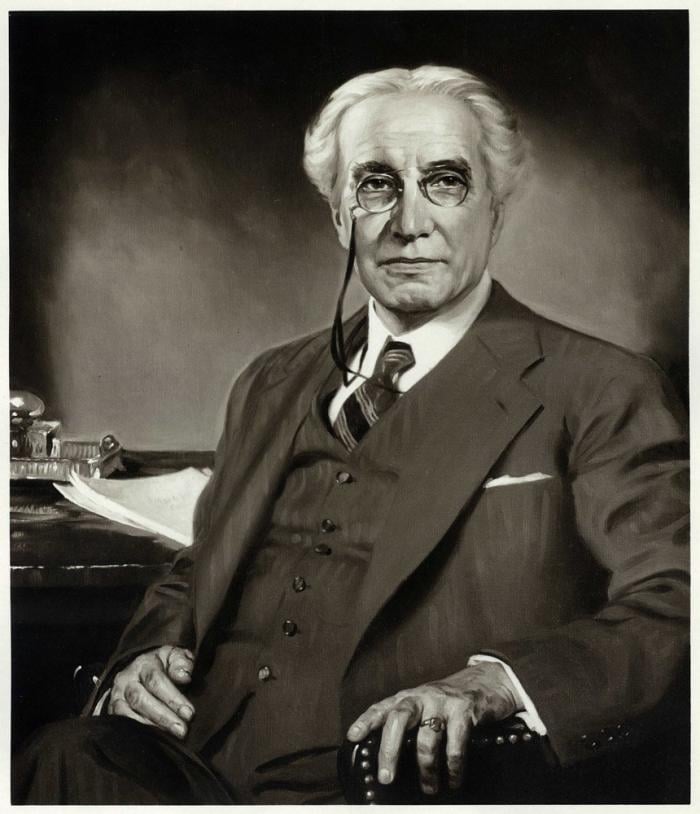
Bulova has seen its fair share of changes in the years since its establishment. Founded in 1875 by Bohemian immigrant Joseph Bulova, the company carried the name J. Bulova Company at first. Then, in 1923, it became the Bulova Watch Company. The Loews Corporation bought the company in 1979 then sold to Citizen by the end of 2007. Despite this, it remains a strong player in the industry and a sought-after brand by collectors.
After almost four decades since its foundation, Bulova only launched its first plant dedicated entirely to the production of watches in 1912. The plant, located in Biel, Switzerland, pioneered the standardised mass production in the watchmaking industry. Right off the bat, Bulova proved itself a strong player in the industry by introducing such a concept. Years later in 1919, the brand finally launched its first complete range of watches for women. About half a decade later, the brand also launched a men’s collection.
American Expansion
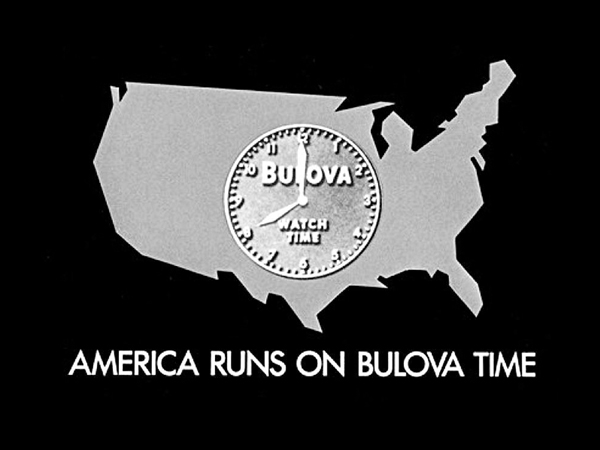
The American market embraced Bulova watches with open arms, perhaps due to the brand’s visual style. Featured on the first advertisement of the brand, this trait left a mark to the American public. However, the brand goes beyond just aesthetics. They also take precision and technological research seriously. In fact, the brand set up an observatory on the roof of a skyscraper located at 580 5th Avenue, New York City, in order to determine universal time precisely.
Soon after, the brand expanded its operations to Woodside, New York, as well as Flushing, New York. There, Bulova introduced necessary innovations that became pioneers in the watchmaking industry. Bulova also developed a number of watchmaking tools that helped not only the brand but other manufacturers. Among the greatest horological feats of the brand include the Bulova Accutron watch. This timepiece used a resonating tuning fork to regulate its time-keeping function.
By 1923, Bulova already established itself as a renowned watch company. In 1926, the brand produced the first radio advertisement, announcing the first beep of history. The advertisement announced, “At the tone, it’s eight o’clock, Bulova Watch Time”. Millions of Americans heard and heeded to this advertisement, pushing the brand to an even higher status as an innovator not only in the industry but also in advertisements.
The Lone Eagle and More Achievements
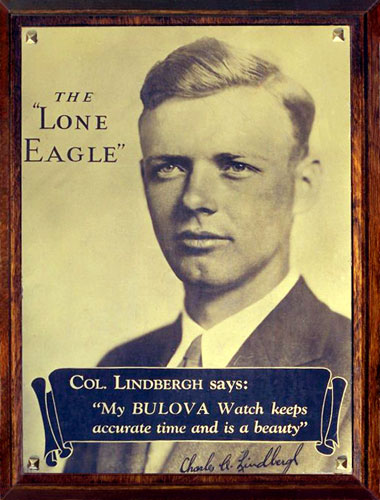
When Charles A. Lindbergh became the first solo pilot to cross the Atlantic nonstop in 1927, he earned a Bulova watch and a $1,000 check as a reward. Bulova used this opportunity to create a model in the likeness of Lindbergh. Thus, the Lone Eagle, one of the brand’s most popular watches.
Less than five years later in 1931, Bulova launched an electric clock, which the brand claimed to be the first in the industry. However, the Warren Telechron Company sold electric clocks as early as 1912. That’s 19 years before Bulova did. Despite this hiccup, the brand found huge success with its rectangular player watches in the 1930s and 1940s. The watches were strongly curved to fit the wrist perfectly.
To further the advertising game of the brand, they also starred in the world’s first television advertisement on July 1, 1941. It happened before a baseball game between the Philadelphia Phillies and the Brooklyn Dodgers. It aired at the New York station WNBT (now WNBC). The announcement cost anywhere between $4 and $9 at the time. It displayed a WNBT test card that looked like a clock with the hands showing the time. At the lower right-hand quadrant, the Bulova logo, along with the phrase “Bulova Time”, can be seen as the second hand swept around the dial for one minute.
Sports Affiliation and Watchmaking School
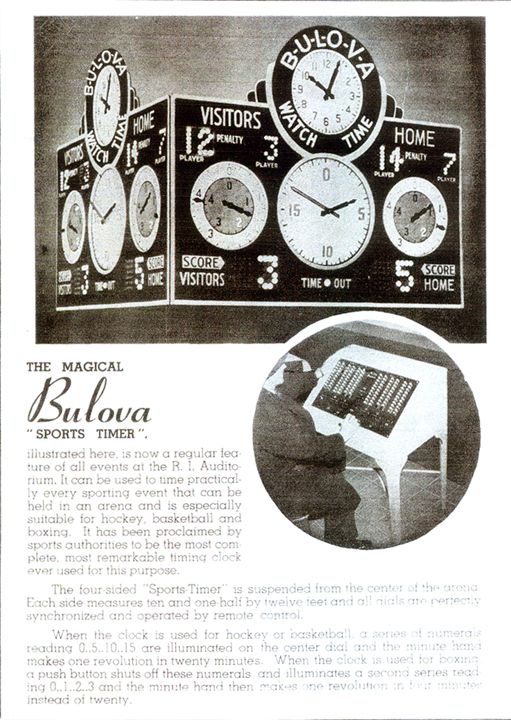
Aside from mainstream media, the brand affiliates itself with the sports as seen on its first TV advertisement. In the 1940s, the brand has its complex four-sided, five-dial per side “sports timer” analogue game clock used at the NHL pro ice hockey games. The same watch also provided time reference for the nascent NBA pro basketball league at the time. The clocks were placed in indoor sports arenas, such as the Boston Garden, Chicago Stadium, and the Detroit Olympia. In 1976, however, the establishments removed the last examples of the clock, replaced by a digital-display game clock.
Bulova decided to share the common love for watchmaking to aspiring watchmakers among veterans through the Joseph Bulova School of Watchmaking. Founded in 1945 by Arde Bulova, the brand’s Chairman of the Board, the school provided training for disabled veterans after World War II. It later became a full-fledged rehabilitation facility. The brand proved itself an advocate for disabled people nationwide, and one of the founders of wheelchair sports in the United States. Sadly, the school closed in 1993.
In 1967, Bulova bought the Manufacture des Montres Universal Perret Frères SA located in Geneva. Ten years later, in December 1977, the brand sold it and its Biel factory closed in 1983. This, however, didn’t stop Bulova from creating iconic timepieces as it led to the launch of the Bulova Oceanographer.
The Launch of the Bulova Oceanographer
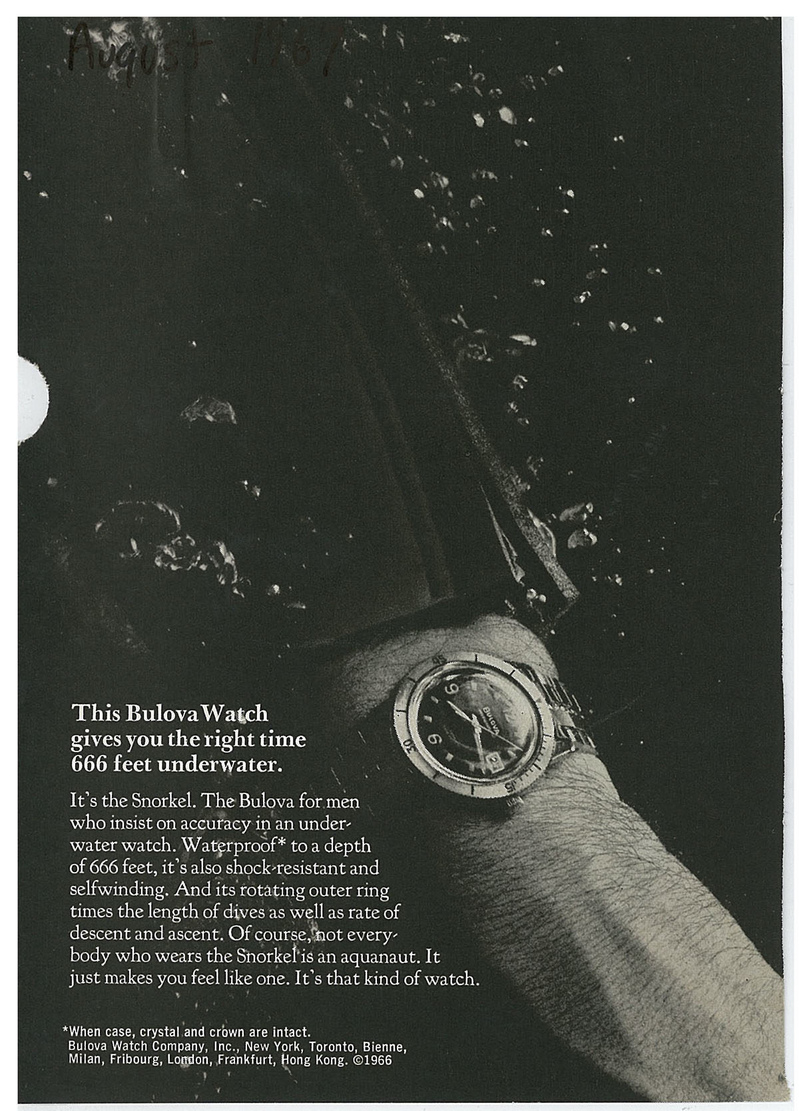
Around the year 1961, Scuba diving was all the hype. This year marked the early days of the sport and it was at the same year that Bulova launched its first purpose-built underwater watch. The watch featured a “compressor” case supplied by Swiss company Ervin Piquerez SA. Such style of a case was not only used by Bulova but other brands as well. This watch boasts a design that gets tighter as water pressure increases. Most Compressor cases could only go as deep as 600ft (200m), but Bulova proved to be an innovator. They pushed the limit of the Compressor to a daring 666 feet. This depth became a healthy measure of assurance for most divers, be it recreational or professional.
This Devil Diver, as the brand nicknamed it, became the first in a long line of Bulova dive watches that went on up to the late 1970s. The watches — namely Deep Sea, Snorkel, and Surfboard — became the go-to watch of athletes, divers, sailors, and other professionals operating in the waters. The Bulova Oceanographer, to say the least, became a pioneer among Bulova dive watches.
The year was 1968 and Bulova just launched the Snorkel. The watch had a crosshair on the dial — a popular design trend at the time. Its markers were three-dimensional with tritium for perpetual illumination. Acrylic resin made up its bezel featuring a bicolour design with the first fifteen minutes in red. This made timing decompression easier to track for divers. In 1669, Bulova included the name “Oceanographer” to the dial. This timepiece proved itself the most popular among all Devil Divers. It also became the watch mostly associated with the brand’s diving history.
The Bulova Oceanographer
Bulova was never a stranger to accuracy. The brand boasts its obsession with it that led its name to rise on the ranks. A self-winding mechanical calibre powers the Bulova Oceanographer, like all Devil Divers. However, with the invention of quartz movements, Bulova went on and incorporated it in the Oceanographer as well. But Bulova didn’t hold back in letting its Accutron 214 tuning-fork movement power the watch as well. Right now, the Bulova Oceanographer functions with a mechanical automatic movement that’s reliable and ISO-certified.
This watch saw a lot of changes in appearance over the years. The first Snorkel watch featured an internal timing ring and two crowns. It also had a tonneau-shaped version with a lot of colours to choose from. Then, it graduated to having angular cases with integrated bracelets popular in the seventies. Despite this, a lot of people still loved the Oceanographer and the changes that came with it.
The 1968 Bulova Oceananographer Snorkel Watch
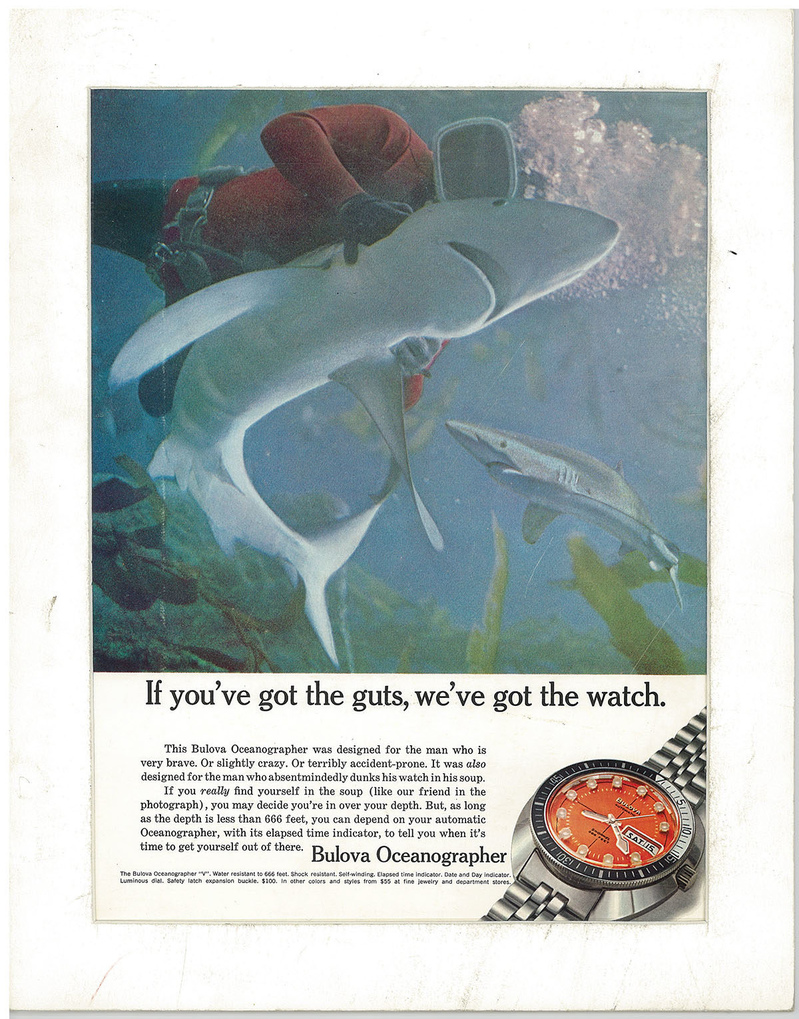
The stainless steel case of this watch gives the impression of a standard watch from the late ’60s through the ’70s. A lot of Seiko watches share the same appeal, but the Bulova Oceanographer proves different in many ways.
Bulova, despite being one of the mid-tier to early top-tier brands, bore similarities with Swiss luxury watch designs, such as the Omega Seamaster. It almost had the same appeal as the Breitling Superocean.
Dial
The Oceanographer Snorkel stands out with the colours it incorporates. Among the colours that stand out aside from its bright orange dial are black, red (on some models), and white. They’re not obstructing and remain at a comfortable shade that doesn’t hurt the eyes. If you look back on watches from its generation, this could have some of the smartest aesthetic choices that top brightly coloured watches. However, the 1970s remain present with its hour indexes. The three-dimensional indexes take inspiration from psychedelic designs with its shape and opaqueness.
The watch is legible with the white tritium-filled large hands. Tritium, also known as hydrogen-3, is a rare and radioactive isotope of hydrogen. This type of lume was common for tool watches especially for a time like this. After radium became outlawed in the late 1960s, manufacturers turned to tritium for a safer option for long-lasting lume. Comparable to radium’s bright glow, tritium is way less radioactive. While it remains a radioactive material, it’s a safer option. This lume could last up to 25 years without fading. For a diver, this could be one of the many pluses of the Bulova Oceanographer. Not only does it not need the sun to “recharge” its lume, but it’s also safe and bright even underwater.
The white directly contrasts the lollipop sweeping second hand. The crosshair also greatly references a design trend of the time. As a tool watch, it’s important to provide more than just time. With the date wheel imperative to it, Bulova equipped a Cyclops glass for better reading. In general, it’s a well-balanced dial perfect for diving and everyday use.
Movement
Bulova used an in-house movement for the Oceanographer. Called the reference 11 BLACD, this automatic movement includes 23 jewels. It’s not a particularly popular movement but Bulova produced it in high volumes for distribution. Whether the vintage Oceanographer you’ll cop works just as well as the original, there’s no assurance. There isn’t much information on this movement, however the great thing about this watch is that it is easily serviceable.
Best Modern-Day Bulova Oceanographer Watches
At the 2018 Baselworld, Bulova launched two new Oceanographer watches. The heritage-inspired watches were launched under the brand’s Archive Collection. Right off the bat, there are many similarities shared by the watches. Firstly, they both take inspiration from the same cushion-cased Oceanographer diver from the 1970s. They also feature a similar flat-top sapphire crystal with an anti-reflective coating protecting the dial. The crosshair dial remains visible plus the raised markers that should not and would not go anywhere in this and future reissues (we hope).
However, there remains quite a gap between the two watches launched at the same time. While the differences can’t necessarily be seen on the outside, the difference are still considerable enough to warrant a higher price for the limited-edition version of the watch.
Firstly, the Bulova Archive Series Oceanographer Devil Diver Limited-Edition features an orange dial. It’s not only a more honest iteration of the original watch but it’s also more expensive. And not only because of the limited edition tag! On the other hand, the Archive Series Oceanographer Devil Diver boasts a few updates on the design. Either way, both watches prove a treat for fans of the Oceanographer.
1. Bulova Archive Series Oceanographer Devil Diver Limited Edition
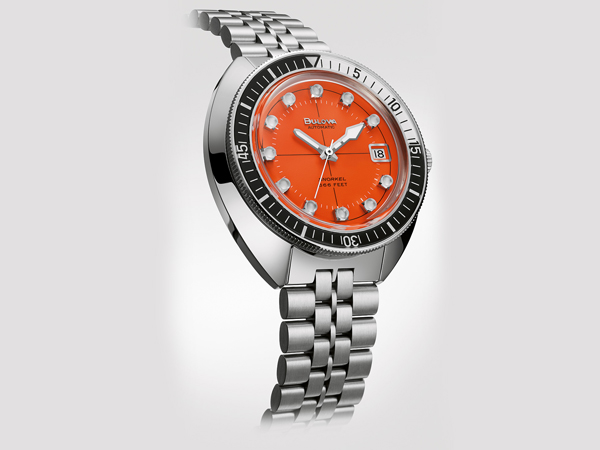
The Bulova Archive Series Oceanographer Limited Edition (98C131) Watch comes with a 40mm case that’s perfectly true to the vintage size. As aforementioned, it also has a bright orange dial with a day and date window located at 3 o’clock. The bezel features a bicoloured insert. The first quarter comes in white, while the rest of the insert is in black. This, too, proves faithful to the original 1970’s Oceanographer. Just as much, the applied metal “Bulova” branding just below 12 o’clock remains true to its reference. The font used for the “Snorkel” inscription above 6 o’clock and the “666ft” goes right where it should be according to the original. Moreover, the watch features a quirky chromed hands that come with bright lume.
With a mechanical automatic movement, the watch also delights in modern technology. Powered by the Swiss Sellita SW220 automatic calibre, it’s a reliable timepiece for today. This movement includes 26 jewels and beats at a rate of 28,800 vibrations per hour.
Fittingly so, the limited-edition model only had 666 models, embraced whole-heartedly by the brand. With a jubilee-style bracelet, it’s also a comfortable fit around the wrist. The watch retailed for $1,495 MSRP. However, given its rarity and limited-edition status, it’s not surprising to find it a couple thousand or hundred more expensive than its MSRP.
2. Bulova Archive Series Oceanographer Devil Diver
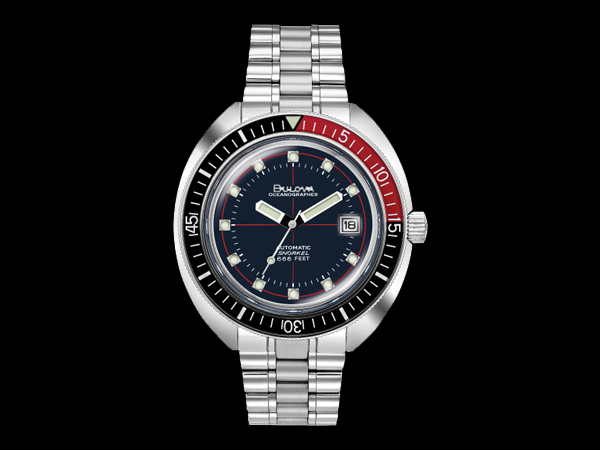
The difference of this watch from the limited-edition re-issue rests on various things. Firstly, the Bulova Oceanographer 98B320 watch comes with a matte black dial and sword hands framed in white. With the luminous paint, however, it’s just as readable. At a distance, you wouldn’t mistake it for an issue with a very honest dial design. However, the case of this watch goes from 40mm to 44mm. This larger case can be polarizing, however, a lot of divers would very much prefer a larger watch any day.
Just like the original watch, the bezel of this watch comes bicoloured, with red for the first quarter and black for the rest. Moreover, this model only features a date-only window at 3 o’clock instead of a day-date window. With the addition of a box sapphire crystal for the magnifier, it’s truly like the original Bulova Oceanographer. As usual, we see the iconic “666 feet” at 6 o’clock with other branding inscriptions like the brand name and the “Snorkel” name.
Another difference between the limited edition reissue and this regular one lies on the movement. This regular edition Bulova Oceanographer from the Archive Series runs on a Japanese Miyota automatic calibre movement. This helps pull the price down to a more affordable range. Keep in mind that both Bulova and Miyota function under the Citizen group. The “bullet” bracelet of the watch also remains comfortable even with the round links it comes with. Priced at $795 MSRP, it can be more affordable or a tad more expensive, but a gap that’s not too alarming.
3. New Bulova Archive Series Oceanographer Devil Divers
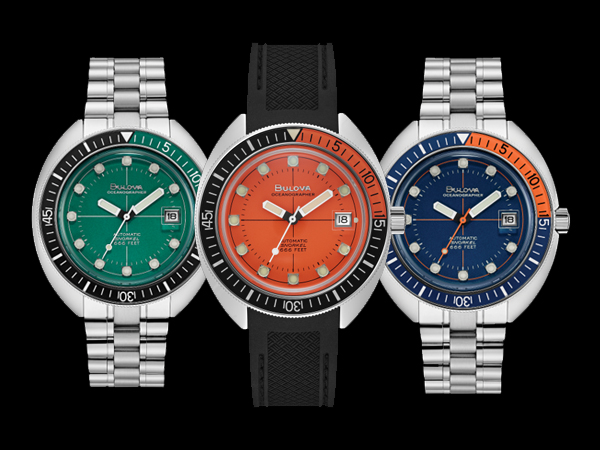
With the success of the 2018 reissue of the divers, Bulova promptly provided more colours to choose from. The regular edition Archive Series Oceanographer comes with new colours, such as the Bulova Oceanographer 96B322 in turquoise green, as well as the Bulova Oceanographer 96B321 in orange and blue . The Bulova Oceanographer 96B320 in blue and yellow colourway is also available for purchase. All watches come with matching bezels.
Similar design features such as the iconic indexes, crosshair dial, and lollipop sweeping hand remain in the new reissues. It has also become available with a more comfortable rubber strap that could go well especially for divers. If not with a rubber strap, the watch comes with the usual bullet bracelet similar with the 2018 re-issue. These timepieces now represent the Oceanographer on Bulova’s present catalogue.
By 2020, the roster grew, adding an orange dial to the list. All watches come with a 44mm case and still feature the usual inscriptions: the metal Bulova branding as well as the words “Snorkel” and “666 feet”. Moreover, other design choices such as the 2018 regular edition reissue don’t differ much.
Final Thoughts
While heritage watches flock the market, Bulova continues to stand out with its design choices and technical features. Many brands such as Seiko, Tudor, and Longines have been launching reissues of iconic watches. All these reissues continue to innovate while remaining true to the original timepieces they’re inspired after. For instance, the Longines Weems Second-Setting Watch proves true to the original. However, the L699 Calibre movement that powers this watch goes by modern standards.
What makes the Bulova Oceanographer such a wonderful timepiece rests on its unique design. A lot of watches can have the same movement but not everyone can carry such an aesthetic the way the Oceanographer does. A lot of collectors particularly love the three-dimensional indexes on the dial. It’s not something you see on other timepieces. Besides, the iconic 666 feet of depth rating also became somewhat of a legend in the dive watch category.
What more does Bulova have in store for us? Only time can tell. There are a lot more possibilities to watch out for when it comes to the Oceanographer and we have yet to see the best version of this watch. For instance, a ceramic bezel could change the game for this watch. Bulova may also incorporate the watch with an even better movement. For the meantime, let’s bask in the beauty of this perfectly executed reissue.
In need of more vintage or vintage-inspired watches for your collection? Check out our list of the best retro watches and Dan Henry watches!
All photos courtesy of Bulova
